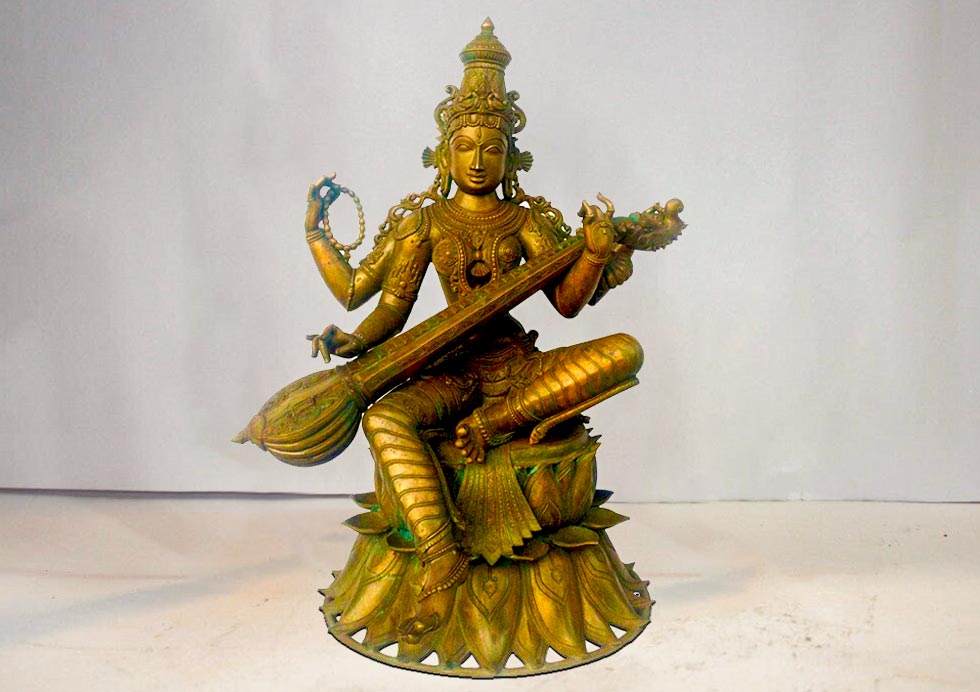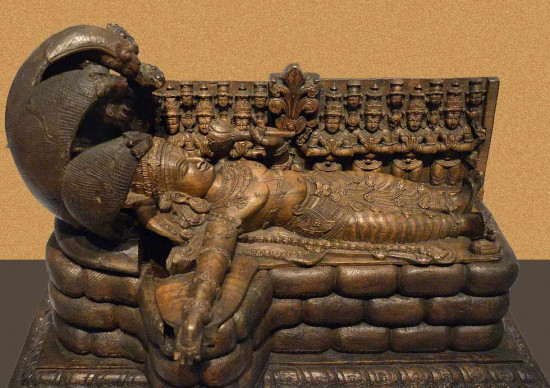
Iconography of Goddess Saraswati
Saraswati typically has four arms, representing manas, buddhi, citta, and ahamkāra – aspects of the mind and self-consciousness. Her hands hold: Vedas, a mālā (rosary) for meditation, a water pot representing purity and discrimination, and a veena, a musical instrument symbolizing creative arts and sciences.
The goddess is associated with a hamsa (swan or goose), symbolizing discrimination between good and evil. Saraswati’s connection to the swan is highlighted by the title “Hamsavāhini.” The peacock, or citramekhala, symbolizes colorful splendor, dance celebration, and the transformative ability to transmute negativity into enlightenment.
In her role as a water and river goddess, Saraswati was initially a personification of the Sarasvati river. Early texts like the Rigveda describe her as a river goddess representing fertility and purity. The story of Saraswati becoming a river involves her transformation after a series of events, ultimately making the waters sacred.
Overall, Saraswati’s iconography captures the essence of knowledge, creativity, discrimination, and purity, offering a profound representation of the goddess in Hindu mythology.

Goddess Saraswati’s depiction in various forms and avatars across different regions and traditions
Dancing Sarasvati: In the Hoysaleswara temple in Karnataka, a portrayal of Saraswati with eight hands showcases her in a classical Indian dance posture. She holds a pen, a palm leaf manuscript, a musical instrument, and tools of major arts, symbolizing her as the goddess of knowledge and all arts.
Mahasaraswati: Venerated in different forms across regions, Mahasaraswati is depicted as an eight-armed goddess seated on a white lotus, holding a Veena. She is associated with a meditation verse in the Devi Mahatmya and is revered for her role in destroying asuras.
Matrika Avatar (Brahmani): In Shaktism, Saraswati takes the form of Brahmani, a Matrika avatar or mother goddess. She is not only the goddess of knowledge but also represents the wisdom of ultimate truth. Her Mahavidya form is Matangi.
Vidhya, Gayatri, Savitri: Saraswati is revered as Vidhya, the formless concept of wisdom and knowledge. In some regions, she is known as Gayatri, the personification of the Vedas, and as Savitri, the consort of Brahma and symbol of purity.
Mahavidya Nila Saraswati: In certain traditions, Nila Saraswati is considered a form of Mahavidya Tara. While traditional Saraswati is calm and compassionate, Nila Saraswati represents the angry and destructive manifestation. She is worshiped in parts of India as an incarnation of Goddess Tara.
Sharada Avatar in Kashmir: The Sharada Peeth in Kashmir is dedicated to the tripartite embodiment of the goddess Shakti—Sharada (learning), Saraswati (knowledge), and Vagdevi (speech). It holds significance as one of the Maha Shakti Peethas and represents the spiritual location of the goddess Sati’s fallen right hand.
These diverse forms and avatars showcase the multifaceted nature of Goddess Saraswati, reflecting her roles in knowledge, arts, speech, and the broader divine feminine energy.
Goddess Saraswati in Hinduism

Epic Literature
In the Mahabharata, Saraswati appears both as a sacred river for pilgrimages and as the goddess of speech and knowledge. Her tranquil riverbanks attract priests and sages practicing asceticism and sacrifices. The Ramayana narrates an incident where Saraswati, as the goddess of wisdom, helps prevent a potential disaster by influencing the boon granted to a rakshasa.
Puranic Literature
In Puranic texts, Saraswati is created by Brahma for the purpose of creation. Various Puranas describe her union with Brahma and her role as the mother of the Vedas, symbolized by her classic four-armed form holding a book, mala, veena, and a water pot while mounted on a swan.
Association with Brahma
The Matsya Purana details Brahma’s intense desire for Saraswati, resulting in her circumambulating him. Faces emerge on the sides and back of Brahma’s head, symbolizing their union’s cosmic significance. The Bhagavata Purana presents an intriguing legend where Saraswati, initially one of Vishnu’s wives, becomes jealous of Ganga’s glances towards Vishnu. This leads to curses, shaping the destinies of Saraswati, Ganga, and Lakshmi.
Shakta Texts
Within Shaktism, Saraswati plays a crucial role in the Devi Mahatmya, part of the Markandeya Purana. This text introduces the concept of the “triple goddess” (Tridevi), where Saraswati, along with Mahakali and Mahalakshmi, represents the saguna (“with form”) emanations of the supreme goddess, Mahadevi. Saraswati embodies the creative and active principle within this divine trinity.
Matangi’s importance extends into Shri Vidya Shaktism, where she is identified as Shyamala, a manifestation of Lalita Tripurasundari’s wisdom power. In this context, Matangi is celebrated in the Syamala Navaratri and is regarded as Lalita’s prime minister.









